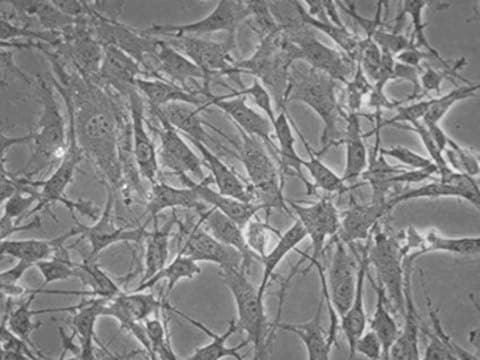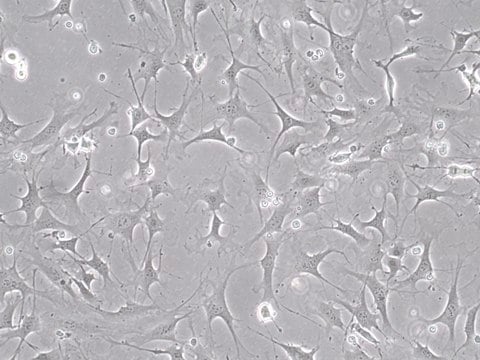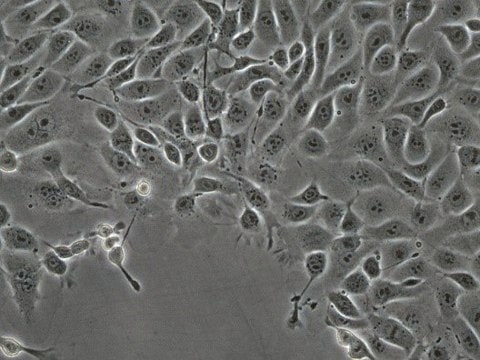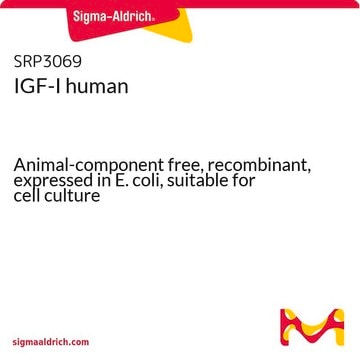SCC136
OP9-DL1 hDL-1-Expressing mOP9 Cell Line
Mouse
Sinônimo(s):
DL1 cell line, Delta-like 1 cell line, Notch ligand cell line, OP9-DL1, OP9-DL1 cell line
About This Item
Produtos recomendados
product name
OP9-DL1 hDL-1-Expressing mOP9 Cell Line,
fonte biológica
mouse
Nível de qualidade
embalagem
vial of ≥1X10⁶ cells/vial vials
fabricante/nome comercial
Millipore
técnica(s)
cell culture | mammalian: suitable
cell differentiation: suitable
Condições de expedição
liquid nitrogen
temperatura de armazenamento
−196°C
Descrição geral
Notch signaling controls multiple cell fate decisions. It is initiated via engagement of the Notch receptor with its ligands (Jagged or Delta-like family members). This is followed by cleavage of the intracellular domain of Notch and its subsequent translocation into the nucleus, where it binds with the transcription factor CBF-1/RBPJ and activates transcription of various downstream target genes. Upregulation of Notch ligands is a factor in chronic inflammatory diseases including pancreatitis and diabetic nephropathy. Several studies have implicated the role of Notch signaling in early T-cell lineage commitments, as it promotes development of T-cells with αα+ T-Cell Receptors (TCRs) at the expense of αα+ TCRs 3. Bone marrow progenitor cells expressing constitutively active Notch have been shown to develop into CD4 and CD8 double-positive T cells. This signaling pathway also plays an important role in the development of CD4+ or CD8+ single positive cells from CD4 and CD8 double-positive precursor thymocytes.
OP9 bone marrow stromal cells support the differentiation of hematopoietic progenitor cells (HPCs) into multiple lineages including B-cells, but not to T-cells. This is mainly because they do not express Delta-like 1 or Delta-like 4 notch ligands inherently. OP9 cells were therefore infected with a MiGR1 retroviral vector engineered to express the human Delta-like-1 gene and green fluorescent protein (GFP). The OP9-DL1 cells were then sorted for GFP expression.
Source
GMO. OP9-DL1 cells were genetically modified from stromal cells derived from mouse bone marrow.
References
1.Immunity 2002, 17(6): 749-756.
2.J Orthop Sci. 2005, 10(6): 589-594.
3.Curr Opin Immunol. 2007, 19(2): 163-168.
4.Cold Spring Harb Protoc. 2009, 2009(2): pdb.prot5156.
Aplicação
- Each vial contains > 1X106 viable cells.
- Cells are tested negative for infectious diseases by a Mouse Essential CLEAR Panel by Charles River Animal Diagnostic Services.
- Cells are verified to be of mouse origin and negative for interspecies contamination from human, rat, Chinese hamster, Golden Syrian hamster, and nonhuman primate (NHP) as assessed by a Contamination Clear panel by Charles River Animal Diagnostic Services
- Cells are negative for mycoplasma contamination.
Características e benefícios
Armazenamento e estabilidade
Outras notas
Exoneração de responsabilidade
Código de classe de armazenamento
12 - Non Combustible Liquids
Classe de risco de água (WGK)
WGK 3
Ponto de fulgor (°F)
Not applicable
Ponto de fulgor (°C)
Not applicable
Certificados de análise (COA)
Busque Certificados de análise (COA) digitando o Número do Lote do produto. Os números de lote e remessa podem ser encontrados no rótulo de um produto após a palavra “Lot” ou “Batch”.
Já possui este produto?
Encontre a documentação dos produtos que você adquiriu recentemente na biblioteca de documentos.
Nossa equipe de cientistas tem experiência em todas as áreas de pesquisa, incluindo Life Sciences, ciência de materiais, síntese química, cromatografia, química analítica e muitas outras.
Entre em contato com a assistência técnica







